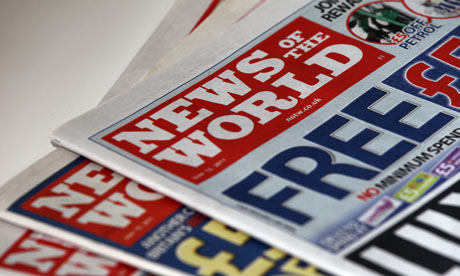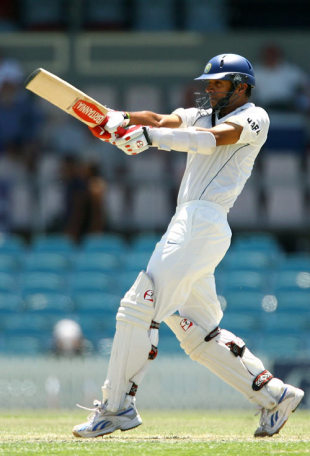Tabloid's publisher aggressively denied scandal – until the latest revelations
- guardian.co.uk,
-
 larger | smaller
larger | smaller

News of the World will print its last ever edition on Sunday July 10, 2011 – the phone-hacking scandal has forced the tabloid's closure. Photograph: Adrian Dennis/AFP/Getty Images
It was a strategy of cover-up, quarter-admission, and foot dragging that took years to unravel – beginning with the first court case brought in the wake of jailing of the News of the World's former royal editor Clive Goodman and the newspaper's £100,000-a-year private investigator Glenn Mulcaire.
At the trial it emerged that five others had their phones or messages hacked into – none of whom were members of the Royal family, subjects of Goodman's work – but prominent individuals Simon Hughes, Elle Macpherson, Max Clifford, football agent Sky Andrew and Gordon Taylor, the chief executive of the Professional Footballer's Association.
Nevertheless, News International chose to gloss over the glaring contradiction of a court case that prompted the resignation of Andy Coulson, as editor, taking the "ultimate sacrifice" for activities he said he was unaware of.
In March 2007, the company's then executive chairman Les Hinton was clear that the hacking scandal was narrow in scope. Giving evidence to MPs on the culture media and sport select committee Hinton said, when asked if Goodman was the only person who knew about phone hacking, he replied that "I believe he was the only person" who was aware of the practice and "I believe absolutely that Andy did not have knowledge of what was going on".
Despite that, though, it was Gordon Taylor's legal team pursued a court case on his behalf. News International offered Taylor £250,000 to quietly settle the case, but he fought on and as his lawyers obtained evidence from Mulcaire's notebooks and tapes seized by the Metropolitan Police, there was early evidence that hacking practice may have spread wider.
Mark Lewis, who was Taylor's solicitor, recalls that it was shortly after the legal team obtained a tape of Mulcaire talking to another journalist (a tape later leaked to the New York Times), that the company's lawyer Tom Crone offered to settle at a higher price.
This time Taylor won a massive £700,000 out-of-court settlement. Crucially, though, News International wanted it to remain confidential – which Taylor had little choice but to agree to, given the amount of money on offer.
Documents relating to the case were sealed, and the matter would never have become public until the existence of the settlement – signed off by James Murdoch on the recommendation of News of the World editor Colin Myler and Crone – was revealed in July 2009 by the Guardian.
That Guardian's report was accompanied by the revelation that private investigators had hacked into "two or three thousand" mobile phones – and the suggestion that MPs from all three parties and cabinet ministers, including former deputy prime minister John Prescott and ex-culture secretary Tessa Jowell, were among the targets.
Two days later, News International responded late on a Friday afternoon with an aggressive denial, authored it is believed by Crone, with some help from Myler, and corporate communications head Matthew Anderson. It concluded there was no evidence to support the contention that "News of the World or its journalists have instructed private investigators or other third parties to access the voicemails of any individuals" or that "there was systemic corporate illegality by News International to suppress evidence".
In reaching the conclusion, News International had two seeming allies. John Yates, the assistant commissioner at the Met, refused to reopen the original investigation into phone hacking, saying that "potential targets may have run into hundreds of people, but our inquiries showed that they only used the tactic against a far smaller number of individuals".
Meanwhile, the regulator also chose to take News International's evidence at face value, concluding in its own enquiry in November 2009 it had "seen no new evidence to suggest that the practice of phone message tapping was undertaken by others beyond Goodman and Mulcaire, or evidence that News of the World executives knew about Goodman and Mulcaire's activities".
Not everybody was so convinced. A growing number of angry celebrities and politicians began to initiate their own lawsuits in the belief their phones had been hacked. Legal actions gathered momentum in 2010, but News International fought every step of the way, while the Met was slow to share evidence with the claimants and key witnesses like Glenn Mulcaire refused to testify.
It was not until December 2010 that Sienna Miller's legal action that alleged that hacking was almost certainly initiated by at least one other journalist – Ian Edmondson, then still employed by the Sunday tabloid.
Even then some appeared in denial. In October 2010, Rupert Murdoch, speaking at News Corp's annual meeting, said "there was one incident more than five years ago" before taking aim at the Guardian. "If anything was to come to light, and we have challenged those people who have made allegations to provide evidence … we would take immediate action".
Andy Coulson, by now working in Number 10 for David Cameron, said as recently as December of last year in the Tommy Sheridan perjury trial that: "I don't accept there was a culture of phone hacking at the News of the World.".
It was not until 2011 – some say at the urging of former Daily Telegraph editor and News International's group general manager Will Lewis – that News International began gradually to soften its stance. Edmondson was dismissed, as it appeared that some of the newspaper's upper-middle ranks could also be under threat.
The company stopped contesting the civil cases in April, reaching a £100,000 settlement with Sienna Miller, although that meant News International would avoid the embarassment of court cases were all sorts of additional evidence could have emerged.
However, it was not until the Met chose to reopen the criminal enquiry after five years of refusal, handing the job to deputy assistant commissioner Sue Akers rather than John Yates, that News Corp had to admit more.
With the police trawling over 11,000 pages of notes, suddenly officers found allegations that the phone of murdered schoolgirl Milly Dowler had been targeted by the newspaper, prompting James Murdoch to concede on Thursday that unnamed "wrongdoers turned a good newsroom bad" and that "this was not fully understood or adequately pursued" by those in charge.
